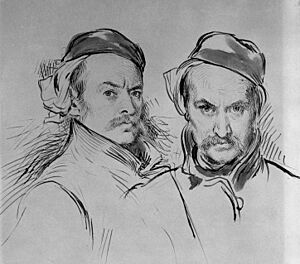Goncourt brothers facts for kids

The Goncourt brothers were Edmond de Goncourt (born 1822, died 1896) and Jules de Goncourt (born 1830, died 1870). They were French writers who worked together on all their books. They are known for writing about real life and for their detailed diaries.
Contents
Family History
Edmond and Jules were born into a family with a small noble background. Their father, Marc-Pierre Huot de Goncourt, was a retired cavalry officer who served Napoléon I.
Their family had owned land in the village of Goncourt, Haute-Marne since 1786. Their grandfather was even a deputy in the National Assembly in 1789. An uncle also served as a deputy in the National Assembly later on. In 1860, the brothers tried to officially use the noble title "de Goncourt," but they were not allowed to.
A Unique Partnership
The Goncourt brothers had a very special partnership. They wrote all their books together. It's said they didn't spend more than a day apart during their adult lives. This close bond lasted until Jules passed away in 1870.
They are famous for their novels and for their personal diaries. These diaries, called the Journal des Goncourt, give us a close look at the lives of French writers and society in the late 1800s.
Their Writing Career
The brothers started their writing journey by describing a sketching trip they took. After that, they wrote books about French and Japanese art and society from the 1700s. Their history books were made from old documents, letters, clothing scraps, and engravings. They tried to show what life was really like back then.
Their first novel, En 18..., was published on a very important day in French history: December 2, 1851. This was the day of Napoléon III's coup d'état, a big political event. Because of this, their book was completely missed by readers.
In their writings, they often preferred the refined style of the 1700s over the more common style of their own time. Their Journal des Goncourt, which they started in 1851, shares many details about the literary and social life of their era.
From 1862, the brothers often visited the home of Princess Mathilde. There, they met other famous writers like Gustave Flaubert and Théophile Gautier. They also started attending special dinners with a group of thinkers, writers, and artists. These dinners included people like George Sand and Flaubert. The brothers carefully wrote down the conversations from these dinners in their Journal.
In 1865, their play Henriette Maréchal was performed. But its very realistic style caused protests, and it was stopped after only six shows.
When they wrote novels, they tried to show the hidden, small truths of everyday life. They published six novels together. One of their most famous is Germinie Lacerteux (1865). This story was based on their own maid, Rose Malingre, who had a secret life they never knew about. After Jules died, Edmond continued to write novels in the same realistic style.
The brothers are buried together in Montmartre Cemetery in Paris.
Their Lasting Impact
Edmond de Goncourt left all his money to create and support the Académie Goncourt. Since 1903, this academy has given out the Prix Goncourt. This is probably the most important literary prize in French literature.
The novel Manette Salomon was first translated into English by Tina Kover in 2017.
Works
Novels
- En 18... (1851)
- Sœur Philomène (1861)
- Renée Mauperin (1864)
- Germinie Lacerteux (1865)
- Manette Salomon (1867)
- Madame Gervaisais (1869)
and, by Edmond alone:
- La Fille Elisa (1878)
- Les Frères Zemganno (1879)
- La Faustin (1882)
- Chérie (1884)
Plays
- Henriette Maréchal (Performed at the Comédie-Française in 1865)
- La patrie en danger (Published 1873, performed at the Théâtre Libre in 1889)
Other Writings
- La Révolution dans les moeurs (1854)
- Histoire de la société française pendant la Révolution (1854)
- Histoire de la société française pendant le Directoire (1855)
- Sophie Arnould (1857)
- Journal des Goncourt, 1851–1896
- Portraits intimes du XVIIIe siècle (1857)
- Histoire de Marie Antoinette (1858)
- Les Maîtresses de Louis XV (1860)
- La Femme au XVIIIe siècle (1862)
- La du Barry (1878)
- Madame de Pompadour (1878)
- La Duchesse de Chateauroux et ses soeurs (1879)
- L'Art du XVIIIe siècle (French Eighteenth Century Painters) (1859–1875)
See also
 In Spanish: Hermanos Goncourt para niños
In Spanish: Hermanos Goncourt para niños


